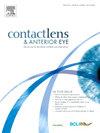Clinical evaluation of the decentration in different designs of scleral lenses
IF 3.7
3区 医学
Q1 OPHTHALMOLOGY
引用次数: 0
Abstract
Purpose
To validate a simple and highly repeatable method of measuring the displacement of scleral lenses from the pupillary center and to quantify scleral lens decentration of two different designs of scleral lens landing zones: spheric (SLZ) and toric (TLZ), with the validated method.
Methods
A prospective crossover study has been performed. Twenty patients (26.90 ± 3.03) with regular corneas participated voluntarily in the study and SLZ and TLZ landing zone Onefit™ MED scleral lenses were fitted. This study was divided into 2 phases. In the first phase, the validation of a new technique, using an image processing tool through the Matlab_R2017b software, to measure decentration was performed, compared with a subjective method consisting of a millimetric grid located in one of the slit lamp eyepieces. Intersession and interobserver repeatability were evaluated in the vertical and horizontal measurements of decentration with both methods. Once the best and higher repeatable method to assess decentration was found, phase 2 started and decentration of two different landing zone designs of scleral lenses were evaluated.
Results
In the first phase, Matlab methodology for decentration analysis showed high repeatability for both horizontal and vertical axes (ICC ≥ 0.9), whereas the slit lamp method demonstrated lower repeatability (ICC < 0.5). Second phase showed a significant reduction in decentration after two hours of wear with TLZ design (p < 0.001), unlike the SLZ design, which had no significant changes.
Conclusion
The measurement of contact lens decentration by image processing using the Matlab software showed a high intersubject and intersession repeatability. SLZ tends to decenter inferiorly and temporarily. A toric landing zone design allows better centration but does not completely reduce the problem of decentration in either the vertical or horizontal axis.
不同巩膜晶状体设计的临床评价。
目的:验证一种简单、高度可重复的测量巩膜晶状体离瞳中心位移的方法,并定量两种不同设计的巩膜晶状体着落区:球形(SLZ)和环形(TLZ)的巩膜晶状体离瞳。方法:进行前瞻性交叉研究。20例正常角膜患者(26.90±3.03)自愿参与研究,并配戴了SLZ和TLZ着陆区Onefit™MED巩膜镜片。本研究分为2个阶段。在第一阶段,通过Matlab_R2017b软件使用图像处理工具进行了新技术的验证,以测量分散,并与由位于狭缝灯目镜之一的毫米网格组成的主观方法进行了比较。用这两种方法对分散的垂直和水平测量进行了间歇和观察者间的重复性评估。一旦找到了评估离体的最佳且可重复性较高的方法,就开始第二阶段,评估两种不同着陆点设计的巩膜晶体的离体。结果:在第一阶段,用Matlab方法进行分散分析在水平轴和垂直轴上均具有较高的重复性(ICC≥0.9),而狭缝灯法的重复性较低(ICC < 0.5)。结论:使用Matlab软件进行图像处理后的隐形眼镜离瞳测量具有较高的受试者间和间歇可重复性。SLZ有向下、暂时性偏心的趋势。环形着陆区设计允许更好的集中,但不能完全减少在垂直或水平轴上分散的问题。
本文章由计算机程序翻译,如有差异,请以英文原文为准。
求助全文
约1分钟内获得全文
求助全文
来源期刊

Contact Lens & Anterior Eye
OPHTHALMOLOGY-
CiteScore
7.60
自引率
18.80%
发文量
198
审稿时长
55 days
期刊介绍:
Contact Lens & Anterior Eye is a research-based journal covering all aspects of contact lens theory and practice, including original articles on invention and innovations, as well as the regular features of: Case Reports; Literary Reviews; Editorials; Instrumentation and Techniques and Dates of Professional Meetings.
 求助内容:
求助内容: 应助结果提醒方式:
应助结果提醒方式:


